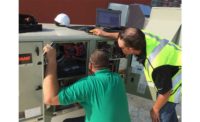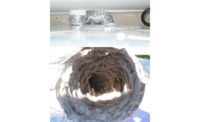Building Ventilation Strategy #1:
The basic industrial building ventilation scheme that architects and building engineers have followed for decades consists of an air supply on one side of the building and exhaust openings on the other. The building is designed to allow the air to move through it, allowing the air within the building to mix and refresh. However, in practice, what usually happens is that the airflow takes the path of least resistance through the building, leaving much of the air stagnant and unaffected. As a result, contaminants that might otherwise be removed remain in the building.
Supporting this Ventilation Strategy with HVLS Fans:
When an HVLS (high-volume, low-speed) fan is introduced into this schematic, all the air is thoroughly mixed. This means that the fresh intake air reaches the entire space, and the contaminants that were previously settled in the far corners of the building are mixed and lifted up to the exhaust opening. HVLS fans support the role of the air-moving system by making it more effective and efficient. This type of ventilation is called dilution because the contaminants cannot stay in concentrated stagnant pockets when the air is mixed. Fresh air dilutes the concentrated contaminates, controlling airborne health hazards and odors.
Dilution ventilation is a strategy best used for standard applications where the quantity and concentration of contaminates is not excessive. Standard use facilities benefit from dilution ventilation, but buildings that reside in abnormal conditions or have processes that produce contaminants require specialized ventilation. HVLS fans support dilution ventilation by destratifying the space, thereby preventing contaminated air from settling in unvented areas.
Building Ventilation Strategy #2:
The other type of ventilation strategy is heat control ventilation. Here the goal is to control exceptionally hot indoor environments to prevent acute discomfort and injury. You might imagine, for example, a manufacturing process where a great deal of heat is generated by machinery or from process furnaces. If that heat isn’t managed, it quickly creates a very unhealthy and physically stressful work environment, so it must be controlled.
What indoor air quality (IAQ) components do we have to work with that can improve this condition? We have the ventilation airflow rate — that’s the volume of air we can move over time, and the velocity — that’s how fast we can move our volume. We also have the additional variables of temperature, humidity, and airflow path.
Supporting this Ventilation Strategy with HVLS Fans:
HVLS fans support heat control ventilation by increasing velocity and expanding the airflow path. Increasing air velocity speeds up convection cooling. Convection is the type of heat exchange that occurs, for example, between human skin and ambient air when the temperature of the air around the skin is cooler than body temperature. Just like a building envelope, the heat moves through the skin from warmer to colder.
But humans also have a biological cooling mechanism called evaporative cooling. That’s when sweat from skin or clothing evaporates into the surrounding air. As sweat or water changes state from a liquid to a gas, it absorbs heat energy and creates a thermal transfer pulling heat from the body, and in so doing, cooling us down. And, unlike convection cooling, evaporative cooling can occur whether or not the air temperature is warmer than body temperature. The only requirement is evaporation.
The Bottom Line:
HVLS fans support the role of ventilation systems by making them more effective and efficient. They also keep workers comfortable by surrounding them with a continuous horizontal floor jet of air wherever they move on the shop floor. Complete your building’s ventilation system by installing HVLS fans.
Publication date: 6/10/2019
Want more HVAC industry news and information? Join The NEWS on Facebook, Twitter, and LinkedIn today!





Report Abusive Comment